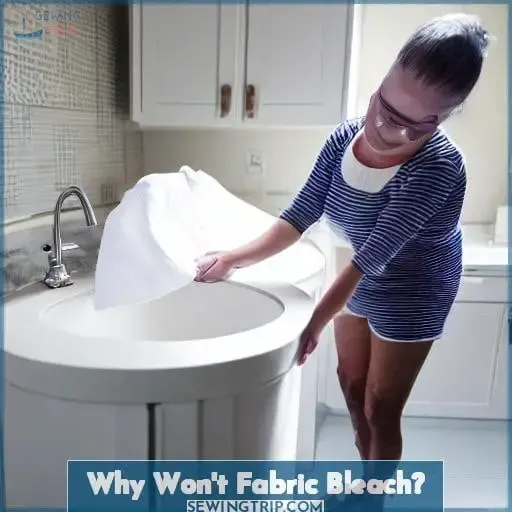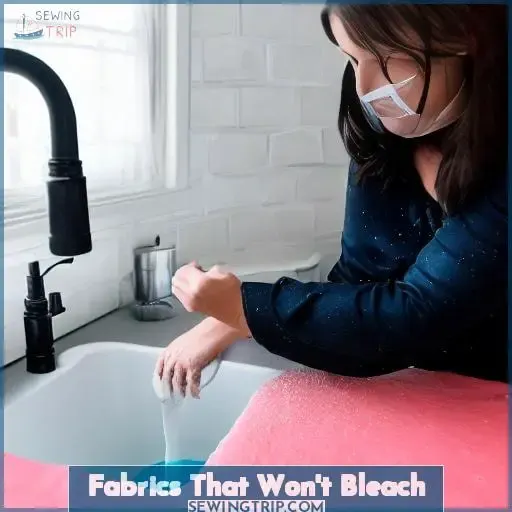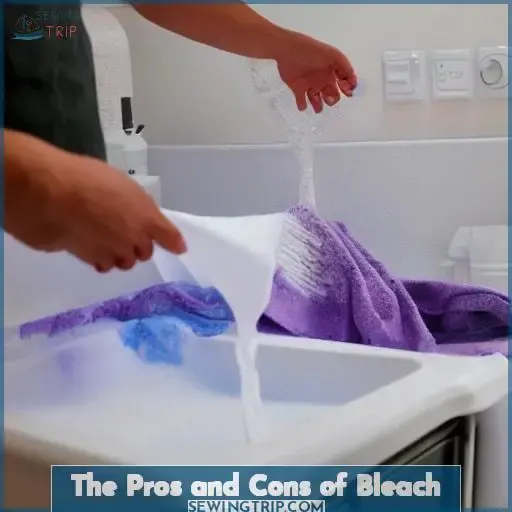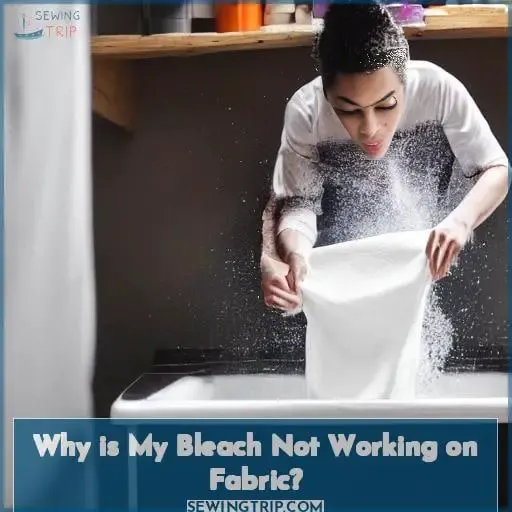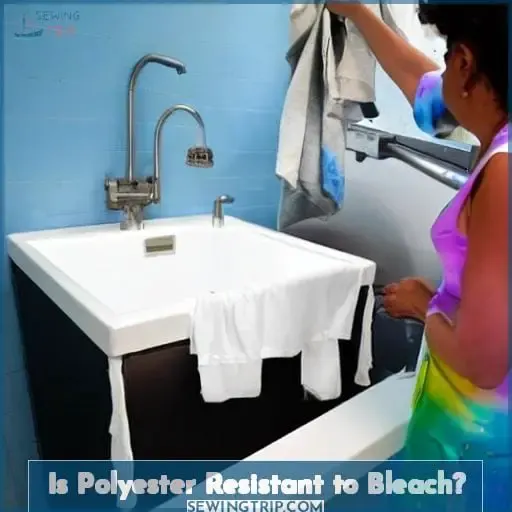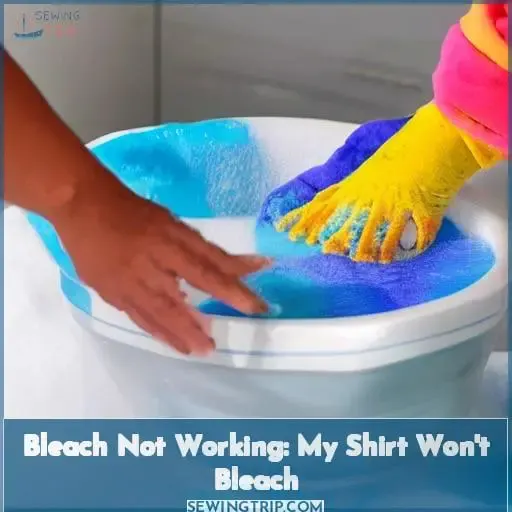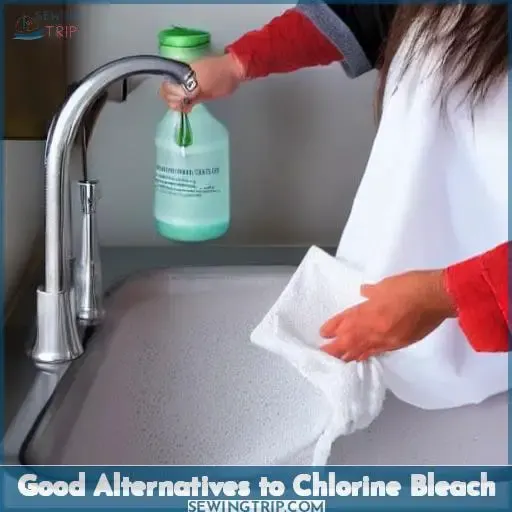This site is supported by our readers. We may earn a commission, at no cost to you, if you purchase through links.
You may be wondering how to bleach fabric that won’t take color out. Bleaching is as much a craft as it is a cleaning job, and requires effort and precision. Think of it as riding an old bicycle up an incline – just the right amount of power at the right time will get you there.
Let’s break down why some fabrics won’t take bleach and what steps can be taken instead.
First, understand that bleaching can be tricky. It takes effort and precision to do it right. So, if the fabric won’t take the bleach, don’t just keep trying – there may be other steps to take.
Second, look for alternative cleaning methods. For instance, if the fabric won’t take bleach, it may be better to use a mild detergent or a fabric-safe cleaning product.
Finally, if the fabric still won’t take bleach, it may be best to consult a professional cleaner. They will be able to assess the fabric and suggest the best course of action to get it looking its best.
In the end, bleaching fabric that won’t take bleach can be a challenge. But with the right steps and a bit of effort, you can still get the results you want.
Table Of Contents
- Understanding the Definition of the Word Bleach
- Why Won’t Fabric Bleach?
- Fabrics That Won’t Bleach
- The Pros and Cons of Bleach
- Why is My Bleach Not Working on Fabric?
- Is Polyester Resistant to Bleach?
- Bleach Not Working: My Shirt Won’t Bleach
- Good Alternatives to Chlorine Bleach
- Frequently Asked Questions (FAQs)
- Conclusion
Understanding the Definition of the Word Bleach
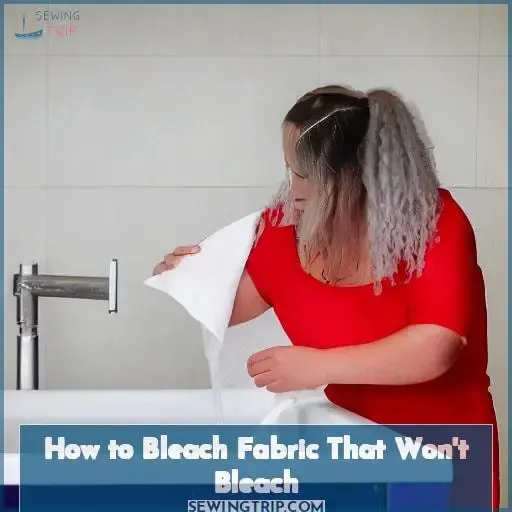
You may be surprised to learn that not all fabrics can withstand the power of bleach! Bleaching is an effective way to sterilize and remove stains, but it can also damage fabrics if used incorrectly. Pre-bleaching steps, such as dampening the fabric first, are necessary for whitening techniques using chlorine free bleaching methods or chlorine bleach alternatives like hydrogen peroxide or oxygen bleach. Synthetic materials are particularly prone to long-term exposure damage from chlorine based solutions.
It’s important to understand the definition of “bleach” before working with any kind of cloth material to avoid damage. Wear gloves and make sure there’s adequate ventilation when bleaching clothes. Consider using natural ingredients like baking soda instead of harsher chemicals. Create a neutralizing solution afterwards by adding 1/3 cup vinegar (if desired) into one gallon water after washing off remaining residue from laundry detergent.
Never leave an item soaking too long in any type of solution unless specified on label instructions or the product website page provided by the manufacturer brand for specific care instructions — even then, proceed cautiously!
Why Won’t Fabric Bleach?
You may be wondering why some fabrics won’t take to bleaching – it’s in the details! Synthetic fibers like nylon, polyester and acrylic are more resistant to bleach than cellulosic fibers like cotton. Special manufacturing or chemical treatment is required for fabrics that won’t bleach. Many natural dyes have been pre-treated with hydrophobic finishing chemicals, preventing oxidizing agents from working. Oxygen bleach isn’t compatible with some materials, and chlorine bleach may damage plastic fibres. Pre-treating fabric before applying any solution will help. Ultimately, experimentation is key!
Fabrics That Won’t Bleach
Do you have a fabric that won’t bleach? You’re not alone! Many synthetic fibers, solution-dyed fabrics, and colorfast designs are designed to resist bleaching. But if it’s important for your project or cleaning needs, there are ways to work around these fabrics and make them more bleachable.
Synthetic Fibers
Try using chlorine bleach on synthetic fibers at your own risk – it can be dangerous and may not produce the desired effect. Polyester, acrylic, and nylon are all synthetic fabrics that should never come into contact with chlorine bleach without caution.
While these materials appear to resist color change when exposed to bleaches or other strong chemicals, they can still be damaged if left in a solution for too long or if the concentration is too high.
As an alternative to using chlorine bleach on polyester clothing care products like sodium thiosulfate have been developed which provide a safe way of lightening colors while also fabric softening benefits as well as reducing yellowing tendencies that sometimes occur during laundering processes with higher energy polyesters such as spandex-containing apparel items.
It’s important to remember that even though some fabrics may look bleach resistant due their chemical makeup there is always room for error, so treat each item you plan on bleaching like a treasure hunt – take time out looking closely at the look of that fabric before beginning any kind of bleaching process!
Solution-dyed Fabric
You won’t believe the amazing transformation you can achieve with solution-dyed fabric. Get ready to be amazed by the vibrant, lasting colors this special treatment provides!
Solution-dyed fabrics are specially treated so that they resist bleaching methods and keep their color for long periods of time. This is achieved through a process in which dye is added during the middle of the fabric making process instead of being applied after it has been made like other fabrics.
With enough bleach, even solution-dyed fabrics may suffer from some degree of dye removal or color correction but since these fibers have been chemically treated, they’ll maintain most of their texture and vibrancy over time than untreated natural fibers when exposed to bleach solutions.
You can use this method on black clothing or brighten up plain hoodies with reverse tie dyeing using natural solutions such as hydrogen peroxide, baking soda mixed into detergent or white vinegar diluted in water without fear that your garment would get ruined due to chlorine damage if used correctly; just make sure there’s enough bleach concentration (10%) present for better results!
Colorfast Design
You can create colorfast designs that stay vibrant longer by using solution-dyed fabrics, which are up to 6x more resistant to fading than other materials. To do so, you’ll need to understand bleaching agents and their effects on fabric. Hydrogen peroxide bleach is a popular alternative to chlorine bleach, as it breaks down into water and oxygen after use. But oxygen or peroxide bleach may not be suitable for silk or wool fibers due to the chemical reaction with leather trim or highlights.
Yarn structure can also affect how well dye will set in fabrics, making them less susceptible to damage from bleach tie dye techniques. Manipulating the concentration of bleaching agents when used alongside different methods, such as dampening fabric before applying diluted solutions, helps achieve desired results while maintaining colorfastness over multiple washes.
3 key steps towards creating a durable colorfast design:
- Use solution-dyed fabric
- Understand bleaching agents and their effects on fabrics
- Manipulate concentration and application methods of bleaches or substitutes for desired results.
The Pros and Cons of Bleach
You may be wondering whether it’s worth the effort to use bleach on fabric that won’t normally bleach. While there are pros and cons of using this chemical, you can use specific techniques to increase your chances of success.
It’s important to understand how chlorine bleach works. What fabrics are resistant? Which alternatives might be better suited for your needs? Before attempting a project with bleaching agents, consider these questions.
Pros
You can benefit from the power of bleaching agents, such as hydrogen peroxide or chlorine bleach, to create vibrant colorfast designs that will last. Oxiclean solution and hydrogen peroxide are great alternatives for natural dyes without harsh chemicals. Sunlight bleaching is an option if you don’t want to use a chemical-based product like Oxyclean. Tea tree oil can be added directly to your laundry load, or used with a gentle cleanser instead of chlorine bleach. Polyester thread won’t damage when exposed to fabric dye remover or a cup of bleach – just make sure you take safety precautions!
Cons
You should be aware of all the potential risks associated with using bleaching agents, such as skin irritation and harm to the ozone layer – it’s estimated that one tonne of chlorine bleach is equivalent to releasing 400 kg of carbon dioxide into the atmosphere.
Alternatives exist for those looking for a safer way to bleach fabrics. Dyeing techniques like solution-dyed fabrics or pre-treating fabrics can help resist bleaching effects, while natural solutions like hydrogen peroxide, baking soda and white vinegar are gentler alternatives than chlorine bleach.
Safety precautions must be taken when handling or working with any type of chemical agent: protective gear such as gloves and goggles should always be worn; disposable foil dishpans used instead of traditional kitchenware so chemicals do not contaminate food surfaces; and respirators used in areas where there may be exposure to fumes from strong solvents or cleaning agents.
Why is My Bleach Not Working on Fabric?
If you’re having trouble bleaching a fabric that won’t seem to respond, it could be because the fabric is resistant to bleach, the bleach solution is too weak, or it’s been previously dyed. It’s important to understand why your bleach isn’t working, so you can find solutions and get excellent results.
Here we’ll explore what might be causing this issue with your project.
The Fabric is Resistant to Bleach
If you thought bleaching was off the table for your fabric, think again! There’s always a way to make it work. While chlorine bleach isn’t suitable for all fabrics or dyes, oxygen bleach or Oxi Clean can be used as natural alternatives on certain materials.
If your fabric is made of cellulose fibers like cotton, linen and hemp and has at least 50% of those fibers in its blend, then you may have success with an oxygen bleach solution. Other things to consider are the type of dye used and how it was applied to the cloth – if this makes sense in relation to achieving desired results when bleaching.
Pure bleach should only be used on polyester-based materials, as other types could suffer permanent damage from strong concentrations. Otherwise, look into color fixing solutions such as Rit Color Remover which can help restore faded garments without any actual bleaching taking place during that process either.
With a bit of experimentation (and safety precautions) taken beforehand, there are various methods out there worth exploring until reaching a successful outcome when attempting how to Bleach Fabric That Won’t Bleach.
The Bleach Solution is Too Weak
If the concentration of your cleaning solution is too low, it won’t be strong enough to get the job done. Bleaching processes vary depending on fabric types; some fabrics are more resilient than others and require stronger oxidizing agents. Natural bleaches can also be used, but must follow proper dilution ratios to effectively remove stains. Chlorine bleach should always be diluted before use, as its full strength can cause chemical reactions that damage fabrics or release toxic fumes at high temps. It’s important to remember both sides: too little won’t do anything, while too much will harm your garments!
The Fabric Has Been Previously Dyed
If your fabric has been dyed before, it may be more difficult to get the desired results with a cleaning solution. Oxalic acid can help remove dye from black fabrics, and sunlight bleaching is also an option. Oxygen bleach and hydrogen peroxide are two alternatives that won’t damage the fibers as chlorine bleach would.
All-natural or hypoallergenic detergents work best on pre-dyed fabrics, as they don’t contain any harsh chemicals which could damage the fibers during wash cycles.
Remember, these solutions won’t just provide color change or unique design features in your fabric, but also won’t damage the fibers.
Is Polyester Resistant to Bleach?
You may be wondering if polyester is permeable to potent peroxide. It is a synthetic material and can be damaged by chlorine bleach when exposed for too long or the concentration of the solution is too strong. Though some fabrics appear to resist bleaching, long-term exposure can still damage them.
Bleaching techniques should take into account not only fabric type, but also safety measures, such as using appropriate concentrations of bleach solutions and natural bleaches like lemon juice or sunning clothing regularly instead of using harsh chemical cleansers that could cause further damage to resistant fabrics like polyester.
It takes hard work and trial-and-error experimentation to understand which materials are best suited for bleaching, so it’s important to consider all negative aspects before diving into any project!
Bleach Not Working: My Shirt Won’t Bleach
Are you having trouble getting your shirt to bleach? Find out why it won’t and how to fix it! Bleaching is removing color from fabric, but not all fabrics are the same. Synthetics like nylon, polyester and acrylic may appear resistant, but long-term exposure can damage polyester. Alternatives like hydrogen peroxide or oxygen bleach are safer for sensitive skin. Lemon juice and water is better for whites, and baking soda boosts laundry detergent’s cleansing power. Reverse tie dyeing uses reductive chemicals on absorbent cellulose fibers like cotton, linen and hemp, but overbleaching could ruin delicate materials. Tea tree oil added to the wash load sterilizes and restores color without damaging the garment. That makes it an ideal choice for stubborn stains without harsh chemicals.
Good Alternatives to Chlorine Bleach
If you’re looking for an alternative to chlorine bleach that won’t damage your fabrics, lemon juice, white vinegar and tea tree oil are all good options. Lemon juice is a natural bleaching agent with antibacterial properties. White vinegar can help brighten fabric and remove odors. Tea tree oil has antifungal properties, making it effective at removing stains from fabric without damaging the material itself.
All three of these alternatives will help keep your fabrics looking their best!
Lemon Juice
You can brighten your whites easily with a natural bleach alternative – lemon juice! It’s an oxidizing agent with acids which act as bleaching agents, and works on light-colored materials and new fabrics that don’t normally bleed with oxygen or chlorine based products. To use it, mix one cup of lemon juice with four cups of water and soak the fabric overnight. Then wash in cold water as usual. This is an ideal way to how to bleach fabric that won’t normally be affected by other good alternatives like hydrogen peroxide and baking soda, while avoiding any damage caused by chemical-based products.
White Vinegar
Try using white vinegar to brighten your fabrics – the all-natural way! It has oxidation effects on fabric and can help preserve its original color. This method of bleaching is more gentle on fabric than other alternatives, reducing the risk of wear and tear from aging.
Mix one part white vinegar with eight parts water in a second dishpan or bucket. Add the desired amount of clothing items that need to be whitened into this solution, depending on their type. Let them soak for at least 30 minutes (or up to four hours if needed).
Rinse off any excess acetic acid before washing your newly bleached clothing normally according to instructions listed by manufactureru2019s tag.
Tea Tree Oil
You can use tea tree oil to whiten fabrics and make them look new again. It’s a natural bleaching agent and removes stubborn stains. Use it directly on the item – like a black shirt with bright spots – instead of a strong bleach solution. Test on an inconspicuous area first if the fabric’s sensitive, like viscose rayon. With proper care, you’ll have beautiful garments looking like brand new!
Frequently Asked Questions (FAQs)
How do you know when fabric is suitable for bleaching?
It can be tricky to bleach fabric that won’t normally take a dye. Certain types of fabrics like nylon and polyester won’t take bleach due to their chemical makeup and should be avoided. Colorfast clothing items may also need special consideration since they’ve been chemically treated to preserve color – they usually don’t respond well when exposed or soaked in chlorine bleach solutions. Traditional tie-dye methods often work better with natural bleaches, like lemon juice or baking soda, which don’t require pre-treating your garment with chemicals before use. But if you’re wanting a black garment, only using chlorine bleach is recommended. With careful planning and safety precautions, you can get beautiful results from any fabric type using the right techniques and knowledge of different bleaches available today!
Are there any fabrics that should not be bleached?
When it comes to bleaching fabrics, there are some that should be avoided. Natural dyes and dark garments, such as black or navy blue, can be damaged by bleach. Fabrics made of plastic fibers, like polyester and nylon, won’t respond well either – chlorine bleach will ruin them over time.
Cotton is the most resistant fabric when it comes to bleaching, but you still need to take precautions. Use a diluted solution at first with Oxi Clean or other eco-friendly products. Then, if needed, increase the concentration slightly while keeping an eye on any unwanted splashes from getting onto surrounding clothing items in your washing machine’s load.
Once done, wash off all remaining residue with water before sun drying for best results!
What is the safest method for bleaching fabric?
When it comes to bleaching fabric, the safest method is to use natural soaps or oxygen bleach. Baking soda can be added to laundry detergent when washing clothes in a machine for an extra boost of cleaning power. If you want to stop the bleaching process, spray a solution of water and vinegar on your clothing or soak them with salt before rinsing them off. Sunlight exposure is also a good idea; it helps kill germs and bacteria without harsh chemicals while still brightening fabrics naturally.
How can you minimize the damage caused by bleach?
When bleaching fabric, it’s important to use the right techniques and types of bleach to minimize damage. Pre-bleaching steps are key – test a small sample or look into the fiber structure. If it’s a bleach-resistant material, try using larger amounts of diluted bleach (1/4 cup per gallon) with other solvents like white vinegar or lemon juice. Place the fabric in a large plastic dishpan and cover it completely. Then add two teaspoons for every quart of water used – this ensures all areas are exposed evenly.
Done correctly, bleaching fabrics can produce interesting results without much harm!
Are there any precautions I should take when bleaching fabric?
When bleaching fabric, it’s important to take precautions to minimize damage. Make sure you select a fabric that can handle bleach. Look out for fabrics treated with chemicals to resist dye removal. Read specific instructions on the product label. Different brands of bleach may require different amounts of time or concentrations for soaking. Don’t exceed five minutes. Rinse thoroughly after each step until all remaining bleach solution is washed away from the garment. Otherwise, you’ll have a hard time getting rid of any discoloration later, which could be why your project isn’t working.
Conclusion
Congratulations! You’ve made it through the article and have all the knowledge you need to start bleach tie dyeing. Wear protective gear and work in a well-ventilated area. With patience and precision, you can craft beautiful, unique patterns with bleach dye.
Run some tests and experiment with different concentrations of bleach to get the results you’re looking for.
So, grab your gloves and goggles and get ready for a wild and wacky adventure with bleach tie dye.

